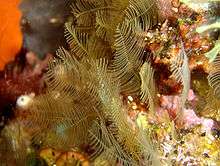Plumularioidea
| Plumularioidea | |
|---|---|
 | |
| Aglaophenia species (Aglaopheniidae) | |
| Scientific classification | |
| Kingdom: | Animalia |
| Phylum: | Cnidaria |
| Class: | Hydrozoa |
| Order: | Leptomedusae |
| Suborder: | Conica |
| Superfamily: | Plumularioidea McCrady, 1859 |
Plumularioidea are one of the few rather robustly established superfamilies of the cnidarian suborder Conica.
This superfamily unites about 30 genera in the following families:[1]
- Aglaopheniidae Marktanner-Turneretscher, 1890
- Halopterididae
- Kirchenpaueriidae
- Plumulariidae Agassiz, 1862
These thecate hydroids grow in erect colonies, branched in some species but unbranched in others. Each branch may bear a single or several animals. In the latter case the hydrothecae are arranged in a neat single file; in either case they are not set on stalks but grow from the branches directly. The hydrothecase have a cusped or even rim and instead of a diaphragm a well-defined floor with a hydropore that is usually off-center. The hydranths have a conical hypostome – as is typical for the suborder Conica – and a single whorl of thread-like tentacles. The gastrodermis contains areas with and others without digestive function. Nematophores are always present and usually protected by nematothecae. The gonotheca are borne singly or in groups, they may or may not have protective hydrocladia or appendages. The gonophores are usually fixed sporosacs, more rarely they are rather reduced medusoids.[1]
Footnotes
References
- Schuchert, Peter (2008): The Hydrozoa Directory - Suborder Conica Broch, 1910. Retrieved 2008-JUL-08.